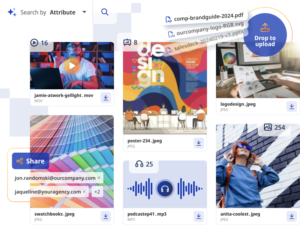Dropbox vs. digital asset management (DAM) – which one is right for your business?
Understanding the limitations of Dropbox vs. the power of DAM
Let’s be blunt: Dropbox is not a digital asset management (DAM) solution. It’s a cloud storage tool, not the right system for managing brand assets, creative content, and marketing files at scale. If you’re still relying on Dropbox to store and manage business-critical assets, you’re losing time, productivity, and opportunities.

So, what’s the difference between Dropbox and a DAM? Let’s break it down.
What is digital asset management (DAM)?
A digital asset management (DAM) system is a purpose-built platform that centralizes, organizes, and distributes brand assets—images, videos, presentations, design files, and documents. Unlike Dropbox, a DAM platform uses AI-powered search, metadata tagging, and workflow automation to streamline asset retrieval, approvals, and collaboration.
If your team spends more time searching for files than creating content, you need a DAM, not Dropbox.
The cost of inefficiency: why businesses can’t afford to rely on Dropbox
Time is money, and every hour spent searching for lost files translates to lost productivity. Research shows that employees spend an average of 20% of their workweek searching for documents and assets—time that could be spent on revenue-generating activities. If you have a large creative team or a growing asset library, sticking with a storage-first approach like Dropbox will only slow you down.
Why Dropbox fails as a digital asset management tool
1. No AI-powered search – you’re stuck digging through folders
Dropbox relies on manual organization, while DAM platforms use AI-driven metadata tagging to help teams instantly locate assets with smart search features. This means no more guesswork, no more wasted time—just instant access to the right content.
2. No version control – leading to outdated and duplicate files
With Dropbox, there’s no built-in version tracking, approval workflows, or brand governance. This lack of structure can result in multiple versions of the same file floating around, causing inconsistencies and errors. DAM platforms provide version control, ensuring that teams are always working with the latest, approved content.
3. Lack of asset security & permissions
Dropbox doesn’t offer granular permission settings for access control. A DAM lets you define user roles, restrict file downloads, and maintain brand consistency across teams. This is crucial for protecting sensitive marketing materials, legal documents, and proprietary brand assets.
4. No creative workflow automation
A DAM integrates with design and marketing tools like Adobe, Canva, and project management platforms, streamlining asset approvals and creative workflows—Dropbox doesn’t. Imagine a scenario where you need to approve an ad campaign—a DAM can automate that process, reducing delays and making your workflow more efficient.
5. Not built for enterprise scalability
As your digital asset library grows, Dropbox becomes harder to manage. DAM systems scale effortlessly, keeping everything structured, searchable, and easily accessible. A DAM ensures that your team isn’t buried under an ever-expanding pile of files, making it easy to manage thousands or even millions of assets.
Why ASMBL is the best Dropbox alternative for digital asset management
If you’re ready to move beyond Dropbox and upgrade to a DAM that actually works, ASMBL delivers:
- AI-powered search & smart tagging – Find assets instantly with AI-driven metadata.
- Real version control & approval workflows – Ensure your team always uses the latest files.
- Role-based access & asset security – Control who can access, edit, or download assets.
- Automated workflows & creative collaboration – Streamline marketing, design, and content approvals.
- Seamless integrations – Works with Adobe Creative Cloud, Canva, WordPress, and project management tools.
- Scalability for growing businesses – Whether you have 1,000 or 1,000,000 assets, ASMBL grows with you.
Real-world impact: how companies benefit from DAM over Dropbox
Still not convinced? Here’s how businesses like yours have transformed their workflows by switching from Dropbox to a DAM:
- Marketing teams reduced asset search time by 85%, allowing them to focus on campaign execution instead of hunting for files.
- Creative teams streamlined collaboration with automated approval workflows, cutting project turnaround times in half.
- Retail brands maintained consistent branding across global campaigns by centralizing assets and ensuring only approved materials were used.
Dropbox vs. DAM: which is right for your business?
If you need basic file storage, Dropbox is fine.
If you need real digital asset management, AI-powered search, and structured workflows, ASMBL is the answer.
Stop wasting time searching for files. Upgrade to ASMBL and streamline your workflow today.
